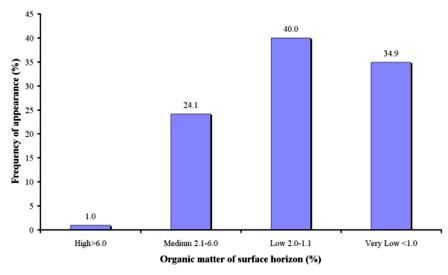Organic matter in surface horizons
Soil organic matter represents a key indicator for soil quality, both for agricultural functions (i.e. production and economy) and for environmental functions (e.g., carbon sequestration and air quality). Soil organic carbon is a major indicator influencing physical, chemical and biological soil parameters. Aggregation and stability of soil structure increase with organic matter content. These in turn increase infiltration rate and available water capacity of the soil, as well as resistance against erosion by water and wind. The development of agriculture has caused a large loss of soil organic matter. Global climatic change may have a similar effect. Apart from climatic factors (mainly drought and temperature), the main processes causing losses in soil C are: cultivation of undisturbed land, soil erosion, mineralization of organic matter, leaching of dissolved organic and inorganic substances. Soil erosion by water or wind, represents the most important soil organic matter decline process. There are several land management practices for soil carbon conservation, such as reduced or zero tillage, application of biosolids (manure, crop residues, and compost), cover and deep-rooting crops, conservation of grassland and woodland, improved rotations, fertilization and irrigation.
Soil organic matter has been determined in the study field sites by chemical analysis of soil samples of fine earth (materials pass through a 2 mm sieve). The dichromate method has been used for organic carbon determination. The following classes have been defined: (a) high organic matter content OM>6%); (b) moderate, OM=2.1-6.0%; (c) low, OM=2.0-1.1%; and (d) very low, OM<1.0.
Data for the organic matter content in the soil surface horizon have been collected in 1136 field sites, corresponding to 14 study sites (Table 3). As Fig. 29 shows, the majority of the study soils had low (2.0-1.1%) to very low (<1%) organic matter content, covering 40.0% and 34.9% of the study field sites. Such amounts of organic matter content were found in all study sites except for Novij Saratov-Russia. Moderate (2.1-6.0%) amounts of organic matter was found in 22.2% of the study sites corresponding to all study sites except for Guadalentin Basin Murcia-Spain, and Zeuss Koutine-Tunisia which had lower amounts. High amounts of organic matter in surface horizon have been measured in very few field sites of Boteti Area-Botswana, Cointzio catchment-Mexico, and Mamora Sehoul-Morocco. These field sites correspond to forested land.

Fig. 29. Distribution of soil organic matter content in the surface soil horizon measured in the study field sites